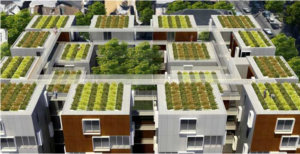
Around the globe, cities are working to become more sustainable through green, white, and blue roofs, solar and wind energy, and an array of carbon offsetting incentives.
Here’s what’s happening in cities around the world now:
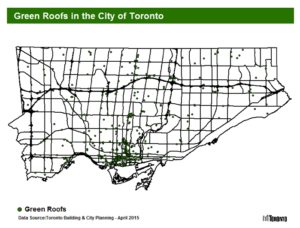 In May 2009, Toronto became the first city in North America to mandate green roofs on all new developments, including residential, commercial and institutional (with a minimum Gross Floor Area of 2,000m2 / 21,530ft2). The city’s initiative is a success story, with 260 green roofs and 196,000m2 / 2,110,000ft2 of green roof area created since 2010. In fact, according to the Green Roofs for Healthy Cities’ ‘Annual Green Roof Industry Survey,’ Toronto took the #2 spot, just behind Washington DC, for the most square feet of green roofs installed in 2014.
In May 2009, Toronto became the first city in North America to mandate green roofs on all new developments, including residential, commercial and institutional (with a minimum Gross Floor Area of 2,000m2 / 21,530ft2). The city’s initiative is a success story, with 260 green roofs and 196,000m2 / 2,110,000ft2 of green roof area created since 2010. In fact, according to the Green Roofs for Healthy Cities’ ‘Annual Green Roof Industry Survey,’ Toronto took the #2 spot, just behind Washington DC, for the most square feet of green roofs installed in 2014.
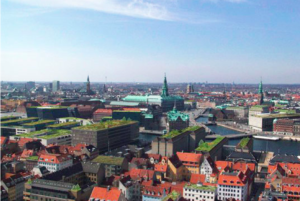
Rooftops in Copenhagen, Denmark
- Copenhagen became the first Scandinavian city to adopt a policy requiring all new development with roof slopes of 30% or less to be green. The same law has also been adopted in Zurich.
- In 2001, Tokyo mandated new buildings 1,000m2 / 10,760ft2 or larger be covered by at least 20% of greenery.
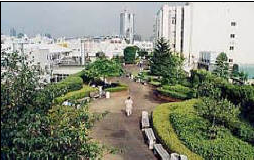
Garden Roof in Tokyo, Japan
Instead of mandating green roofs, many municipalities in the U.S. offer a range of incentives to encourage vegetation over other roofing options.
- In the city of Baltimore, the not-for-profit Blue Water Baltimore, offers a green roof incentive of $2 per square foot of green roof installed. Although the municipality itslef does not provide green roof incentives, it does allow green roofs to replace other stormwater management requirements.
- Chicago consistently ranks in the Top Five for North American metro regions with the greatest area of green roof installations per year. In the past, the city offered to cover up to 50% of the installation cost for green roofs (capped at $100,000). In addition, commercial development projects integrating green technologies receive expedited permits.
- Washington, D.C. installed 1.2 million square feet of green roofs in 2014, more than any other North American Metro Region for the fourth year running. The capital offers a robust green roof rebate program, with base funding of $10 per square foot, and up to $15 per square foot in targeted subwatersheds. Amazingly, there is no cap on the project size for these rebates. Green roof sites are also eligible for up to a 55% discount on stormwater fees depending on how much rainfall their roofs mitigate. Additionally, sites that reduce stormwater runoff beyond the minimum requirements can earn credits. These credits can then be sold through an exchange to buildings that are unable to meet requirements. Because of D.C.’s expansive benefit package for green roofs, it’s no surprise that as of November 2015, there were 232,719m2 of green roofs, amounting to 58 acres of rooftop vegetation. https://1.usa.gov/1OcuirZ
- In New York City property tax abatement has increased from $4.50 to $5.23 per square foot of a green roof, up to $200,000 or the total tax liability of the building for the year in which the abatement is taken, whichever is lesser. The application deadline extended to March 15, 2018, for tax years beginning this July 1, and ending June 30, 2019.
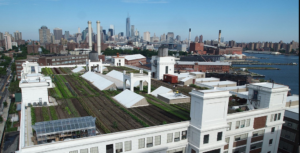
Brooklyn Navy Yard – Rooftop
- The New York City Department of Environmental Protection offers a Green Infrastructure Grant for projects that manage the first 1” of rainfall/stormwater in targeted areas. Projects awarded a grant are reimbursed for 100% of the design and construction costs of green roof projects. Eligible projects include blue roofs, rain gardens, green roofs, porous pavement and rainwater harvesting on private property in combined sewer areas. (1)
Benefits of Green Roofs
There are many benefits to green roofs. Here are just a few:
- Adding natural beauty and major aesthetic improvement to buildings, which in turn increases the investment opportunity.
- Helping contribute to landfill diversion by prolonging the life of waterproofing membranes, using recycled materials, and prolonging the service of heating, ventilation, and HVAC systems through decreased use.
- Green roofs assist with storm water management because water is stored by the substrate, then taken up by plants, and thus returned to the atmosphere through transpiration and evaporation. They also retain rainwater and moderate the temperature of the water and act as natural filters for the water that does run off. They delay the time at which runoff occurs, which results in decreased stress on sewer systems during peak periods.
- The plants on green roofs do a great job of capturing airborne pollutants and other atmospheric deposition. They can also filter noxious gasses.
- They open up new areas for community gardens, commercial and recreational space in busy cities where this space is generally quite limited. (2)
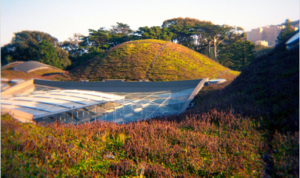
The roof on San Francisco’s Academy of Sciences
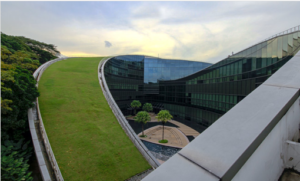
The roof on the Nanyang Technological University Campus in Singapore
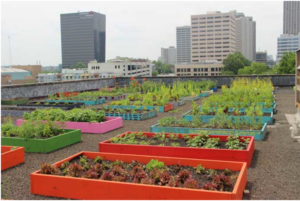
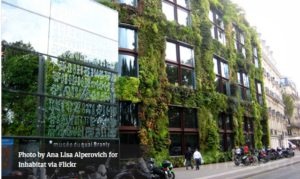
Footnotes
(1) Information found in article by Ruby Lyon and Alan Burchell: France’s Famous Eco Roof Law Too Green To Be True
(2) Information found in article by Liam S. Whittaker: France Declares All New Rooftops Must Be Topped With Plants or Solar Panels

